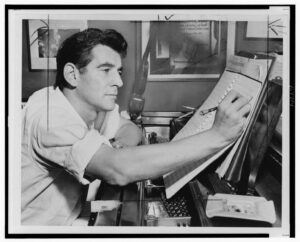The project
Leonard Bernstein was one of the most important conductors of the 20th century, and till this day remains an influential figure in the world of classical music. He is famous for his contagious enthusiasm for music which he shared with the world in many ways, including via conducting. There are many biographies on Bernstein describing his career and personal life, plenty books describing his efforts and importance in the music industry, and many more anecdotes on the way he ‘dances’ on the podium in front of the orchestra:1Laird et al., Bernstein, Leonard; Burton, Leonard Bernstein; Secrest, Leonard Bernstein.
Vid. 1.1 Bernstein, Tchaikovsky Symphony No. 52Ramsay Snow, Tchaikovsky – Symphony 5 (Bernstein), [45:51]
When looking at the excerpt above, Bernstein indeed seems to be having a jolly good time on his little podium, but what about the quality of his conducting? Is it effective conducting, or more of a theatrical show for the audience? John Elliot Gardener described this dancing in an interview as follows: ‘There was somebody [Bernstein] who had more of the physical energy of rhythm in his body, in his little finger, than any conductor I’ve ever seen before or since. It was not just that he danced on the platform in a way that was unpalatable to a lot of people, but didn’t worry me because it seemed to me that he was not trying to say, “Look at me, I’m having a wonderful time!”, but he just couldn’t prevent it. It was as natural to him as swimming. And he had this amazing ability to make the players go along with that rhythmical current.’3Caillat, The Art Of Conducting – Great Conductors Of The Past, 1:51:48
Remarks like this are large in number because it was such a distinctive feature of Bernstein’s style. However, there is little to no research describing Bernstein’s conducting style with regard to the actual conducting techniques such as baton technique. In fact, there is not much of that on any conductor. This research aims to paint a more complete picture of what kind of conductor Bernstein was by analyzing video material of him conducting using eight basic principles of conducting, and comparing his ways to his teachers, contemporaries and conductors after his time. To this end this research will focus on Bernstein in his role as conductor without ignoring, but not meticulously examining either, his other musical activities such as composing and teaching, for there is plenty profound research written on that part of his life already. Therefore, the research question is: what conducting techniques did Leonard Bernstein use and what is his position in the history of orchestral conductors?
This research aims to provide the reader with the information necessary to extract the general conducing techniques and Bernstein’s quirks and habits that make up his personal style from video material.

Fig. 1.1. Leonard Bernstein4Getty Images, Leonard Bernstein Smoking At Piano
Methodology
There is some literature available on conducting technique, but there is no consensus among conductors on what proper technique entails. When looking at drawings of beat patterns for example, one will see that one conductor will move through the tact points – the points in the beat pattern that correspond to the beats of the bar in the score – like in figure 1.2, while others argue it is better not to move further down than the tact point.

Fig. 1.2. Neutral-legato 4/4 beat pattern5Rudolf, The Grammar Of Conducting, 9
In a similar manner there are a thousand other nuances and different uses of beat patterns alone. For this reason, literature is not suitable as a reference point in the analysis of Bernstein’s conducting technique. Therefore, this research will make use of a comparative approach. I will compare Leonard Bernstein’s conducting style to conducting by maestros before and after him by conducting several case studies on video recordings of the same pieces. In these case studies I will analyze the maestro’s conducting techniques by considering a set of eight basic principles of conducting technique that I extracted from literature on this topic. For these case studies I will compare various conductors performing as much as possible the same piece, for this will decrease the chance of biased judgement as the conducting style per conductor may very well vary from piece to piece. Of Bernstein’s teachers Fritz Reiner and Serge Koussevitzky there is relatively little video material because they were active during the early days of the video camera. Hence Beethoven’s Egmont Overture is the only overlapping piece of repertoire that is available on video of both of Bernstein’s teachers and himself. In case there was no video recording of the Egmont Overture available for other conductors that appear in this research, I tried to go for the next best option: another piece by Beethoven or otherwise a composer from the same period. However, in some cases where the style of music was not of much importance for the argument of the video, music by other composers is used as well.
In this research I will first discuss some history on orchestral conducting and explain some general principles of conducting to provide the reader with the background knowledge on conducting that is needed to follow the analysis. Thereafter follows a general description of Bernstein’s conducting style, followed by the more detailed comparative analysis of his conducting techniques.

Fig. 1.3. Leonard Bernstein6World Telegram & Sun, Leonard Bernstein, Half-Length Portrait, Facing Right, Seated At Piano, Making Annotations To Musical Score.